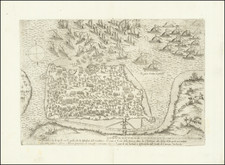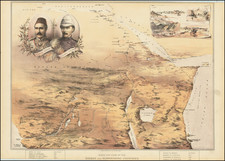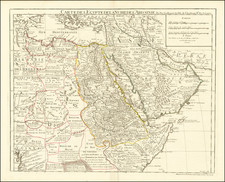An African Association Map Illustrating The Travels of Friedrich Hornemann and William Browne.
Highly detailed map of North Africa and Egypt, extending from Cairo and the Lower Nile River Valley to Tripoli, Mourzuk and the Sahara, published in London by James Rennell.
The map illustrates the routes of two European travelers, whose travels would be reported and described by the African Association in 1802.
The African Association, which later became part of the Royal Geographical Society, was a nongovernmental group of patrons of wealth, learning and influence. Sir Joseph Banks, the association's treasurer for several years, was closely involved from the outset. Other notable members included William Wilberforce and Josiah Wedgwood. Begnning in 1788, the Association published a regular journal.
Friedrich Conrad Hornemann
Friedrich Conrad Hornemann (1772-1801) was a German explorer in Africa. in 1796, he offered his services to the African Association of London as an explorer in Africa. The African Association sent him to the University of Göttingen to study Arabic and otherwise prepare for an expedition from the east into the unknown regions of North Africa. In September 1797 he arrived in Egypt, where he continued his studies.
When the country was invaded by the French, Hornemann remained in the citadel at Cairo to preserve him from the fanaticism of the populace. Liberated by the French, he received the patronage of Napoleon Bonaparte. On September 5, 1798 he joined a caravan returning to the Maghreb from Mecca, attaching himself to a party of Fezzan merchants who accompanied the pilgrims. As an avowed Christian would not have been permitted to join the caravan, Hornemann assumed the character of a young mamluk trading to Fezzan. He then spoke, but indifferently, both Arabic and Turkish, and he was accompanied as servant and interpreter by Joseph Freudenburg, a German convert to Islam, who had thrice made the pilgrimage to Mecca. Traveling by way of the oases of Siwa and Aujila, a black rocky desert was traversed to Temissa in Fezzan. Murzuk was reached November 17, 1798.
Here Hornemann lived until June 1799, traveling thereafter to the city of Tripoli, where in August, 1799 he sent his journals to London. He then returned to Murzuk. Nothing further is known with certainty concerning him or his companion. In Murzuk, Hornemann had collected a great deal of trustworthy information concerning the peoples and countries of the western Sahara and central Sudan, and when he left Tripoli it was his intention to go directly to the Hausa country, which region he was the first European to locate. "If I do not perish in my undertaking", he wrote in his journal, "I hope in five years I shall be able to make the society better acquainted with the people of whom I have given this short description."
The British consul at Tripoli heard from a source believed to be trustworthy that about June 1803 Jusef (Hornemann's Muslim name) was at Caina (i.e. Katsina, in Norther Nigeria), in good health and highly respected as a marabout. A report reached Murzuk in 1819 that the traveler had gone to Noofy (Nupe), and had died there.
Hornemann was the first European in modern times to traverse the north-eastern Sahara, and up to 1910, no other explorer had followed his route across the Jebel-es-Suda from Aujila to Temissa.
William George Browne
William George Browne (1768 - 1813) was an English traveler, whose journey took him through Egypt and the Near East. Browne was murdered while attempting to reach Tehran.
Inspired by James Bruce's travels, and of the first discoveries made by the African Association, Browne became an explorer of Central Africa. He went first to Egypt, arriving at Alexandria in January 1792. He spent some time in visiting the oasis of Siwaor Jupiter Ammon, and employed the remainder of the year in studying Arabic and in examining the ruins of Ancient Egypt.
In the spring of 1793 he visited Sinai, and in May set out for Darfur, joining the great caravan which every year went by the desert route from Egypt to that country. This was his most important journey, in which he acquired a great variety of original information. He was forcibly detained by the sultan of Darfur and endured much hardship, being unable to effect his purpose of returning by Ethiopia (then known as Abyssinia). He was, however, allowed to return to Egypt with the caravan in 1796; after this he spent a year in Syria, and did not arrive in London till September 1798.
In 1800, Browne again left England, and spent three years in visiting Greece, some parts of Asia Minor and Sicily. In 1812, he once more set out for the East, proposing to penetrate to Samarkand and survey the most interesting regions of central Asia. He spent the winter in Smyrna, and in the spring of 1813 traveled through Asia Minor and Armenia, made a short stay at Erzurum, and arrived on the June 1 at Tabriz. About the end of the summer of 1813, he left Tabriz for Tehran, intending to proceed further eastwards, but was shortly afterwards murdered. Some bones, believed to be his, were afterwards found and interred near the grave of Jean de Thévenot, the French traveler.












![Barbaria [with] Cartaginis sive potius Tunetani celeberrimi Sinus nec non fortalitij . . . [with] [Untitled map of Egypt]](https://storage.googleapis.com/raremaps/img/small/72788.jpg)
![(First state!) Tabula Africae III [includes Babylon, the Nile and the Red Sea]](https://storage.googleapis.com/raremaps/img/small/94647.jpg)
![Egypt and Barca [with] Abissina and Nubia [with] Congo. Angola. Cafres. Monoemugi. Monomotapa. Zanguebar & Madagascar](https://storage.googleapis.com/raremaps/img/small/78890.jpg)